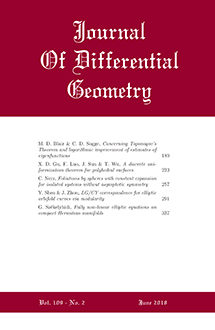Abstract
We define deformations of certain geometric objects in hyperbolic 3-space. Such an object starts life as a hyperbolic plane with a measured geometric lamination. Initially the hyperbolic plane is embedded as a standard hyperbolic subspace. Given a complex number t, we obtain a corresponding object in hyperbolic 3-space by earthquaking along the lamination, parametrized by the real part of t, and then bending along the image lamination, parametrized by the complex part of t. In the literature, it is usually assumed that there is a quasifuchsian group that preserves the structure, but this paper is more general and makes no such assumption. Our deformation is holomorphic, as in the λ-lemma, which is a result that underlies the results in this paper. Our deformation is used to produce a new, more natural proof of Sullivan's theorem: that, under standard topological hypotheses, the boundary of the convex hull in hyperbolic 3-space of the complement of an open subset U of the 2-sphere is quasi-conformally equivalent to U, and that, furthermore, the constant of quasiconformality is a universal constant. Our paper presents a precise statement of Sullivan's Theorem. We also generalize much of McMullen's Disk Theorem, describing certain aspects of the parameter space for certain parametrized spaces of 2-dimensional hyperbolic structures.
Citation
D.B.A. Epstein. A. Marden. V. Markovic. "Complex earthquakes and deformations of the unit disk." J. Differential Geom. 73 (1) 119 - 166, May 2006. https://doi.org/10.4310/jdg/1146680514
Information





